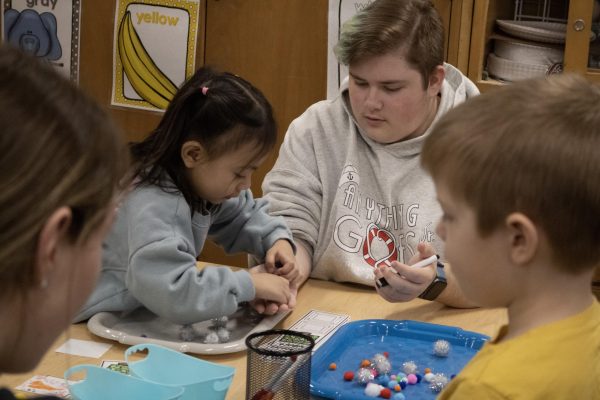Teachers reveal, compare previous occupations

Demonstrating a sparring stance to his karate class, English teacher Austin Smith teaches karate. Smith has taught karate in multiple different locations, this one specifically was in Maywood Fine Arts. Photo courtesy of Austin Smith
May 20, 2016
At Glenbrook South, many teachers originally started on a different career path. These careers have ranged from a news reporter to a watermelon farmer in Israel.
English teacher David Garbe was a news reporter at a small newspaper company in Chicago for five years. According to Garbe, he became interested in journalism after joining his high school newspaper during his senior year.
“As I got to do it professionally, it was a really fun job,” Garbe said. “Getting to talk to people, hearing their stories, learning how different life is for different people and also just learning how the world works. You sort of take things for granted before you need to explain them.”
According to Garbe, he finds teaching more enjoyable than being a reporter, because it has more benefits that meet his changing scheduling demands. Garbe also thinks that his age might have impacted his decision to switch careers.
“I think that as a older person now, I like the less frantic schedule without working nights and weekends,” Garbe said. “I also have a family now, and I get to be home. And money’s a factor, too. As a writer, you are constantly scrambling for more work.”
According to history teacher Daniel Zapler, he worked on a Kibbutz, a communal plot of land in Israel, which is typically a farm. On the Kibbutz, he was a watermelon farmer. Zapler said that he really wanted to live in a Kibbutz for a while, and while he was in Israel he was able to get that opportunity.
“So I always wanted to live on a Kibbutz for some time, so I met these people who lived on it and came back and volunteered for a month or two,” Zapler said. “As a political science major, I was always interested in how people addressed communism.”
Because of the connection with people and plant, Zapler found the experience more enjoyable. According to Zapler, there is a connection between labor and the product of your plans.
“There is a team concept trying to reach the same goal,” Zapler said. “There’s something really satisfying about making your own food. Your job is physical, you get in shape without going to the health club.”
According to Zapler, there were no negatives to being a watermelon farmer because of all the positive aspects of the job. With his previous experiences in farming and his current career as a teacher, he is able to compare and contrast both of these ventures.
“Sometimes, I would say the biggest problem between farming and teaching is with teaching you can’t always be successful but do everything right as a teacher and fail,” Zapler said. “With farming, you can control your mistake. In a weird way, you’re not entirely in control of your success and failures [in teaching].”
In addition to teaching, English teacher Austin Smith is also a karate instructor. According to Smith, he learned karate when he was 5 years old and still continues to practice to this day. Smiths said he used to be a full-time karate instructor; however, he now only teaches once a week.
“When I graduated, my main karate instructor asked me to help teach some classes,” Smith said. “So about five years ago, I started teaching karate, [but] I don’t teach as often anymore. I used to teach about four days a week, and now I only teach once a week or so.”
Over the years, according to Smith, he has dealt with several different types of racial diversity in each of the neighborhoods he teaches karate.
“Where I teach is out in the Hills, Deerfield and also in Maywood, which is a low income area,” Smith said. “So I’ve enjoyed all of those areas and groups of people. [The variety of locations are] a nice change of pace from what I do here.”
According to Smith, he prefers classroom interaction rather than simply the interaction in the karate dojo.
“I really enjoy being in the classroom here,” Smith said. “I chose to be here at South teaching English because there’s something more about that classroom interaction than just in the dojo, or studio, whatever you wanna call it. But I’ve discovered I can take whatever I do in karate to the classroom.”













